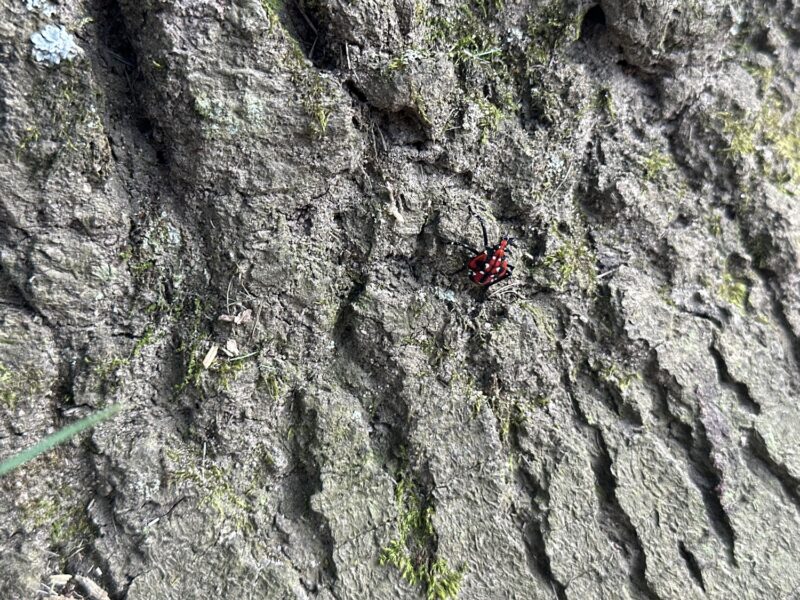

We’re now into what I call the second season. It’s the time of the year when we get back to planting, and it can be as busy in the garden, or busier, than spring. But it’s been an incredibly challenging year for us planters, and with so many things to do and think about, it’s the September ramble.
First and foremost, it’s obviously the drought. Don’t get lulled into complacency simply because we had some rain. It is in every sense just a drop in the bucket. A great deal of damage has been done. Some is clearly visible, like the early leaf drop and the browning of lawns. The reality, though, is that some of the drought damage won’t be seen until next spring and summer when you’ll need to keep a sharp eye on trees, shrubs and fruit trees for signs of dieback and decline. Any plant that has been subject to the stresses of drought two years in a row is susceptible to decline, and any plant that was stressed from disease or insects will suffer as well.
One surprising thing I noticed about the drought is that the flowers on my perennial hibiscus plants have gotten smaller and smaller as the summer progressed. On some varieties the flowers are often 8 inches wide, but as the summer progressed we noted that while the flowers were 8 inches wide in late July, by September they were only 5 to 6 inches wide. I can only assume this is from water stress.
I’ve been thinking a lot about lawns and the drought. I remember being taught that Kentucky bluegrass, the mainstay of many a Hamptons landscape, can only survive for about 30 days without rain. Now for those with irrigation systems, the problem is somewhat ameliorated, but for those without, the only solution will be reseeding or overseeding.
On the other hand, if your lawn is composed of a blend of grass varieties and types, it’s your lawn that will survive the best as other grasses like ryes and some fescues are more drought tolerant. If you have access to a mechanical seeder or if your landscaper has one, this could certainly be the year you’ll want to overseed, even if lightly. It is a risk if the drought continues, and that’s why a full renovation might not be a good idea this year. On the other hand, it seems we’re not in a pattern of repeated droughts.
For smaller lawns and properties, both Scotts and Jonathan Green offer lawn seed mixes that are blended for heat and drought tolerance. The problem will be that the growth habit and color of these grasses may be different from what you have. This is why it’s a good idea to have a folder where you keep the label(s) from the lawn seed that you use so you can try to get as close a mix or the same blend that you’ve been using. If you’re looking for lawn options here’s a link to an article you might want to read: tinyurl.com/2rn7shxn.
The spotted lanternfly and its larvae have certainly invaded the East End in full force this summer. From the North and South Forks there have been numerous reports of these insects showing up just about everywhere. The adults begin to appear in July and are about an inch long and soon will begin to lay egg masses on tree trunks, rocks and even on cars and trucks. They feed on a wide variety of plants, and because they occur in masses they can be difficult to control. More on this insect here: shorturl.at/P1CuB.
Hard to believe, but there is a bit of a silver lining in the drought. Many of the damaging beetles in our landscape such as the Japanese beetle and the Asiatic beetle drop to the ground after feeding and mating, and they lay their eggs into the soil. The eggs and the resulting larvae (grubs) require soil moisture to develop, and in drought years they simply can’t. We’ve already seen populations of both of these beetles vastly reduced as a result of last year’s drought so I’d expect this trend to continue.
And since this week’s column seems to be full of bad news — here’s some more. This one is called laurel wilt, which is a fungal disease, but despite its name it does not affect laurels. It’s being seen mostly on spicebush that’s found in Long Island woodlands and forests, and it also infects sassafras. The impact won’t be seen in landscape plants, but since the berries of the spicebush are important to feeding migratory birds this can impact them. In addition, several moths and butterflies, including the spicebush swallowtail, may be impacted. There are no controls for this disease. Sorry.
It is that time of the year to remind you to be mindful of your soil pH. Few gardeners pay attention to this — the acidity or alkalinity of your garden and lawn soils. Generally we look for a pH of between 6 and 7. Many plants, including azaleas and rhododendrons, prefer a slightly acid soil below 7, but an overly acid soil inhibits the ability of many plants to access critical nutrients. Soil acidity can be affected by acid rain and by the fertilizers we use.
What can you do? Every few years you should have your lawn and garden soil tested. For most of us this doesn’t mean having the soils tested by a lab. You can do home testing with simple test kits available at most garden centers. If the results give you concern then you may want to get a more comprehensive soil test that will show you in detail what the issues are and how to resolve them. In most cases, you may need to add limestone to the soil and this is easily done with granular limestone applied in the fall. The freezing and thawing of the soil and temperature changes over the winter make the limestone break down so it becomes available and starts working next spring.
Thinking about heading up to New England for some leaf peeping this fall? Maybe not. The drought has resulted in very early leaf drop in upstate New York and the surrounding areas, but early reports are saying that the areas around Saranac Lake and Lake Champlain, where there was more rainfall during the summer, will have a good show. There are various websites that make predictions of when the colors will peak, and far upstate it’s usually late October. This year … ????
It’s time for planting and replanting oriental and Asiatic lilies. If you need to dig your own for division or transplanting the time to do this is when the foliage begins to brown and crisp. If you’re looking to do a new planting try to find domestic sources for your bulbs, and if possible shy away from Dutch bulbs as there are ongoing quality control issues. This means finding a domestic source that isn’t selling imported bulbs. Not easy, and it takes some research. One good domestic source is thelilygarden.com.
It’s a good idea to try one or two bulbs of a variety to see how they might perform in your garden, then if you’re happy with what you have, order more for next year. Sadly, as I’ve found out, not all varieties are available every year. A few that I’ve had good success with and are highly ranked by the North American Lily Society are: Black Beauty, Casa Blanca, Silk Road, Fusion, Rising Moon, Conca d’ Or, Eastern Morn, Anastasia, Pink Jazz and Hotel California.
If you’re growing crocosmia or any of the Candy lilies, most can be easily dug, divided and replanted once the foliage browns. Use a garden fork to loosen the soil by pushing it straight down then leaning back on the handle. When the soil is loose you can easily put your fingers into the ground to extract the bulbs (which are actually corms). Leave some behind to regrow, and the surplus can be moved to another spot and planted at the same depth.
It’s nearly garlic planting time. Once you harvest the bulbs (foliage and all) hang them upside down to allow them to dry and cure. We save a number of our bulbs and once cured the cloves are separated and then replanted. I like to buy in a small number (a pound or so) of new bulbs to mix into the planting to keep a bit of genetic variability.
We plant the bulbs (cloves really) the first week in October. Also, know your garlic types. There are a few, and they have different tastes and qualities. They need to grow in full sun, and the cloves are planted root-side down about 4-5 inches apart in rows about 18 inches apart. Closer planting will result in smaller bulbs. The soil needs to be a good garden loam and not sandy. Don’t be concerned if new shoots emerge in the fall.
One important thing though: add some fertilizer. Garlic is a heavy feeder, and forgetting to add fertilizer will result in small cloves. Your soil should have a good amount of well-aged compost and well-rotted manure. It seems the favorite soil amendment is rotted chicken manure as it’s high in nitrogen and other essential nutrients. As an alternative, you can work in small amounts of 5-10-10, bone meal or fish meal into the soil and below where the garlic will be planted. In the early spring use a side dressing of blood meal or another high source of organic nitrogen. This can encircle each plant, but it’s much easier to just run a band of fertilizer one inch from each side of the planting row and gently work it into the top of the soil without disturbing the bulbs. Later in the season, like in June, you may want to add another light side dressing of a vegetable or tomato fertilizer.
One last thing though. Once your garlic is planted, give it a light mulch of shredded leaves or chopped straw (available at garden centers in small bales). This suppresses weeds and keeps the soil temperature stable. Only one to two inches is needed on Long Island but if you are planting in colder places like upstate you may need as much as six inches of mulch. Leave the mulch in place; the garlic stems will push right through it. Keep growing.
 More Posts from Andrew Messinger
More Posts from Andrew Messinger